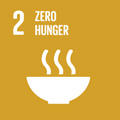- Docente: Frederique Pasquali
- Credits: 3
- SSD: VET/04
- Language: English
- Teaching Mode: Traditional lectures
- Campus: Bologna
- Corso: Second cycle degree programme (LM) in Food Safety and Food Risk Management (cod. 9140)
-
from Sep 18, 2024 to Nov 13, 2024
Learning outcomes
After completing the course students will be able to: understand the importance to trace foodborne pathogens from consumer to fork and viceversa; to subtype and characterize foodborne bacterial pathogens by performing specific phenotypic and genotypic methods and by basic bioinformatic analysis of whole genome sequence data
Course contents
• Taxonomic classification of bacteria: genus, species, subtype
• EU regulations related to surveillance of zoonotic bacterial pathogens, information management system and approved methods for official controls (IMSOC) for foodborne outbreaks
• Phenotypic methods for bacterial typing: serotyping, biotyping and matrix assisted laser desorption/ionisation – time of flight mass spectrometry (MALDI-TOF MS)-based typing
• Genotypic methods for bacterial typing: pulsed field gel electrophoresis (PFGE); Multilocus sequence typing (MLST); Multilocus variable-number tandem repeat analysis (MLVA), whole genome sequencing related typing (Single Nucleotide Polymorphism (SNPs) calling, core and whole genome MLST (cgMLST, wgMLST)
• Genotypic and phenotypic characterisation of antimicrobial resistance
• Molecular international databases available on the main foodborne pathogens: example of application for epidemiological studies
• Example of application of different techniques for epidemiological typing in the food industry.
Readings/Bibliography
lecture notes and scientific publications introduced during lectures
Teaching methods
Oral lectures, seminars held by experts, laboratory activities.
In relation of the types of activities and teaching methods adopted, the attendance of this training activity requires for all students to carry out by e-learning the Modules 1 and 2 [https://www.unibo.it/it/servizi-e -opportunities / health-and-assistance / health-and-safety / safety-and-health-in-places-of-study-and-training] and the participation in Module 3 of specific training on safety and health in study places . Information on dates and methods of attendance of Module 3 can be consulted in the specific section of the degree program website.
Assessment methods
This course is part of the integrated subject "FARM BIOSECURITY AND FOODBORNE RISK” which also includes "FARM BIOSECURITY AND ZOONOTIC DISEASES PREVENTION". Final grading of the entire integrated course is calculated as an average of the scores obtained in the two courses of "FARM BIOSECURITY AND ZOONOTIC DISEASES PREVENTION" and "FOODBORNE RISK TRACEABILITY". The examination commission includes teachers of both courses.
The oral examination will verify the theoretical and applicative knowledges of the student. Particularly positive will be evaluated the ability to move within the different topics and the achievement of an organic knowledge of the topics presented during the lessons.
Teaching tools
Computer, instruments of laboratories of microbiology and molecular biology
Office hours
See the website of Frederique Pasquali
SDGs



This teaching activity contributes to the achievement of the Sustainable Development Goals of the UN 2030 Agenda.
